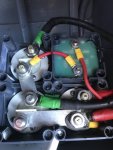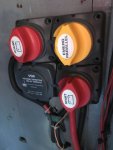Redwing228
Member
We have a two-battery (engine start and 'house') on 'Enfys', both batteries are 110Ah and are charged by an alternator on her Beta 20. The isolators are BEP make with separate switches for each battery and an emergency paralleling switch. There is a VSR connected between the two batteries and is on the supply side of the switches.
On going to the boat last evening we found both batteries almost completely discharged (10V at the terminals) and discovered that the VSR was energised. It must have remained energised since the engine was last run, about 10-days ago. and as it held the two batteries together is has discharged both of them! Utter disaster! I've brought both batteries home to charge them but their condition has probably been harmed as they are both conventional wet cell lead-acid type.
As a quick fix I intend to remove the connecting wires to the VSR and will have to manually manage the batteries by closing the emergency switch to charge both whilst the engine is running.
My confidence in the VSR has been dented. Has anyone else experienced a failure like this? Also, is there a good reason why the relay is on the supply (battery) side of the isolators?
Thanks,
Bill


On going to the boat last evening we found both batteries almost completely discharged (10V at the terminals) and discovered that the VSR was energised. It must have remained energised since the engine was last run, about 10-days ago. and as it held the two batteries together is has discharged both of them! Utter disaster! I've brought both batteries home to charge them but their condition has probably been harmed as they are both conventional wet cell lead-acid type.
As a quick fix I intend to remove the connecting wires to the VSR and will have to manually manage the batteries by closing the emergency switch to charge both whilst the engine is running.
My confidence in the VSR has been dented. Has anyone else experienced a failure like this? Also, is there a good reason why the relay is on the supply (battery) side of the isolators?
Thanks,
Bill


